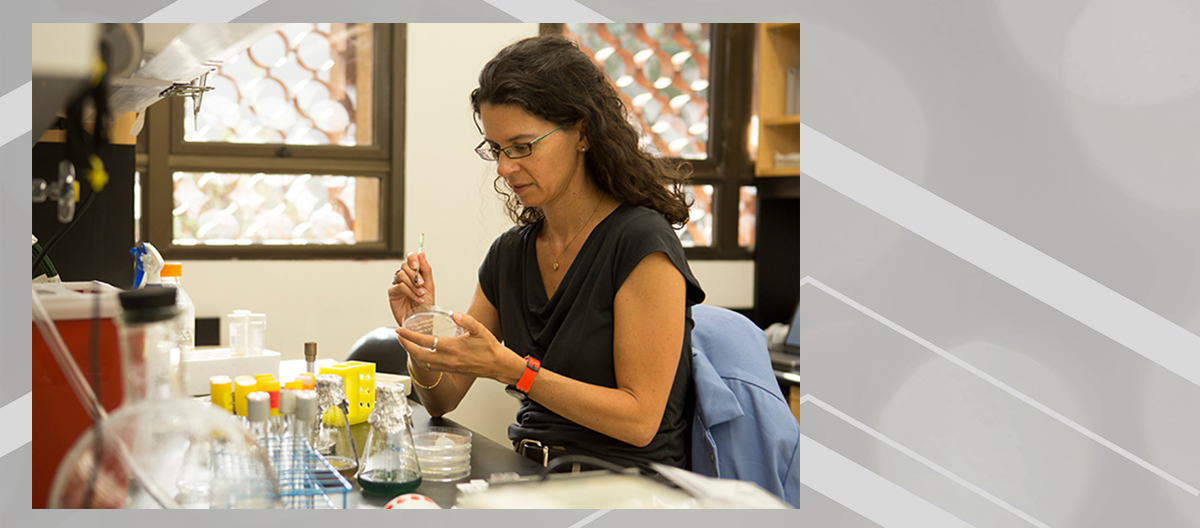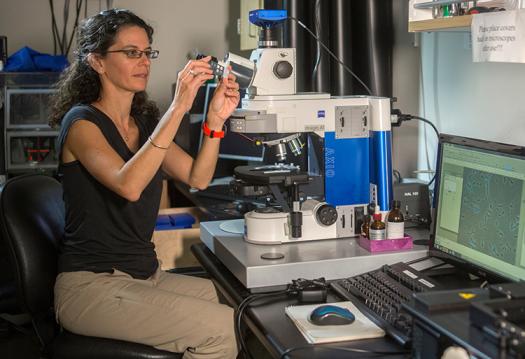This MacArthur Fellow researches how bacteria shaped the Earth

Dianne Newman was recently named a 2016 MacArthur Fellow for her research on the role bacteria played in shaping the Earth and in modern biomedical contexts.
Dianne works with bacterial genetics, studying the metabolic diversity of microorganisms. She also wants to dispel the common misconception that it’s hard to be a woman in science.
HOW DID YOU BECOME INTERESTED IN THIS RESEARCH: In my first semester in graduate school at MIT I took an environmental microbiology class that opened my eyes to the remarkable metabolic diversity of microorganisms. They could clean up toxic organic pollutants in the environment by eating them. In graduate school, I took a life-changing course at Princeton on bacterial genetics. The elegance and power of genetic approaches bowled me over, and I decided at that time I wanted to incorporate that approach into my work.
There is a common misconception that it’s hard to be a woman in science that I’d like to dispel.
With the MacArthur Fellowship, we’ll keep doing what we’ve been doing. I have tremendously talented students and postdocs in my lab, pursuing all sorts of problems. We’ve been taking risks all along, and this award just provides further encouragement to keep doing so.

JOHN D. & CATHERINE T. MACARTHUR FOUNDATION.
TELL US ABOUT BECOMING A MACARTHUR FELLOW: It was an incredible honor, and I was completed surprised. Science is very much a collective enterprise, so I see this as tremendous validation for the work that my lab has done over the past two decades — I proudly share this honor with my students, postdocs and collaborators.
Science is a collective enterprise. This is a tremendous validation for the work my lab has done for 20 years.
In science, we fail more often than we succeed, so this also provides a welcome reminder to keep taking risks and be tenacious in seeing ideas through, no matter how they might be initially received.
SHARE YOUR CAREER HIGHLIGHTS WITH US: One of my favorite memories is writing a review with my first graduate student, Mariu Hernandez. It was published in a lesser-known journal (Cellular and Molecular Life Sciences; Hernandez and Newman) in 2001, but is probably the review that I’m the most proud of. Mariu was an incredibly scholarly student, and working with her to write this review was one of the intellectual highlights of my career. Science is a collaborative, creative enterprise, and it can be very joyful to share.
Mariu and I met daily to discuss papers together. We started reading papers from the 1930s by a scientist named Ernst Friedheim. His papers provided us with tremendous inspiration, and we put his ideas together with more modern findings to advance a hypothesis we’ve been testing ever since.
ON ACCESSIBILITY IN STEM FIELDS: I’d like to help raise awareness that STEM careers are open to anyone with curiosity and a willingness to work hard. Not everyone realizes that you don’t need to go into debt to get a Ph.D. in the sciences. Quite the contrary, actually, your tuition is paid by grants that your advisor or institute raises and you get paid a living stipend. That is such a privilege and so wonderful because it makes advanced degrees in STEM accessible to people regardless of their socioeconomic background.
In many ways, STEM fields are the closest we come in our society to true meritocracies, where you succeed based on your talent and effort. I’d like more people to understand this so we can draw the greatest pool of talent into STEM from younger generations.
You don’t need to go into debt to get a Ph.D. in the sciences. Your tuition is paid by grants and you get paid a stipend.
STEM also offers a great career for people who want to balance career with family. I have a 9-year-old son, and because I’m my own boss, I have the luxury of being able to take time off to go see him in a school play, or be with him for something else that’s meaningful, when I want.
There is a common misconception that it’s hard to be a woman in science that I’d like to dispel. It’s challenging to succeed at a high level in any career — academic science is one of the few where you have a remarkable amount of self-determination, which is highly conducive to balancing career and family.
THE MOST MEMORABLE EXPERIENCE FROM 1987 AND 1988 INTEL ISEF: In high school my favorite subject was physics. My projects focused on natural vibrational modes of different rigid materials. I studied resonance phenomena, and rigged up a system to blast sound waves at differently shaped and sized plates of aluminum, glass, and plastic.
My parents weren’t scientists, but my half-brother is, and he was the person who first made me aware of natural vibrational modes and helped me get started with science projects in 7th grade. I think I went partly deaf in high school as I experimented with raising the decibel level until I hit a resonance mode.
To succeed in STEM: Embrace opportunities, follow varied passions, and develop diverse skill sets.
The phenomenal people who ran the Virginia State Science fair (Nancy Aiello, Ibby Dickson, Sally and Doug Wrenn) became life-long family friends. As a sophomore in high school, I had the opportunity to travel to Puerto Rico for Intel ISEF, which was one of the most exciting experiences of my life.
I got hooked on science thanks to participating in science fairs, which I had to do starting in 5th grade as part of the Fairfax County public school system. It was a requirement of my school, and I am so grateful for that.
Science is most fun when we have the chance to creatively experiment and discover new things. But not everyone has the opportunity to learn like that. I would like to see more schools implement science fairs, since it is the best possible way of getting kids excited about STEM. We should draw the greatest pool of talent into STEM from younger generations.
HOW SCIENCE FAIRS MOTIVATE: Winning awards at my local science fairs and at Intel ISEF was very motivating. But by far the more important part was realizing that I enjoyed the process of science.
I spent time in my basement doing experiments after school because it was engrossing. I enjoyed explaining to people what I had done. That’s what counts: doing things because they are fun and being able to share your enthusiasm with others.
There’s remarkable metabolic diversity of microorganisms.
ADVICE FOR OTHERS INTERESTED IN STEM: Go for it! STEM provides so many paths to very meaningful careers. Be open-minded, and keep trying new things. Don’t feel like you’re boxed into anything in particular — it’s a huge world out there, and when you’re young, you should explore broadly.
Never in a million years would I have predicted when I went to college that I’d wind up doing what I did. Fortunately, the U.S. educational system allows you time to develop. There were many things I did in high school and college that I didn’t think would be relevant to a scientific career, but they turned out to be incredibly important. For example, being on my high school debate team and majoring in humanities in college helped give me confidence in my speaking and writing abilities. These skills are critical for long-term success in a scientific career.
STEM provides so many paths to very meaningful careers.
I’d encourage young people to embrace their opportunities, follow varied passions, and develop diverse skill sets. You can’t predict where they will lead you. Also, young people should appreciate the people in their lives who give them opportunities and encouragement — never take this for granted, and be very thankful.


